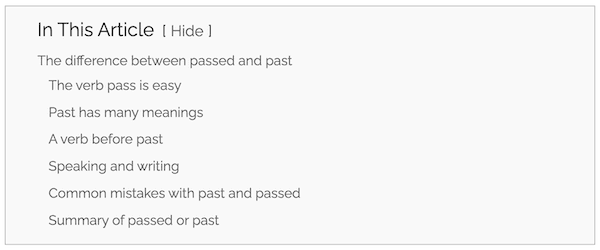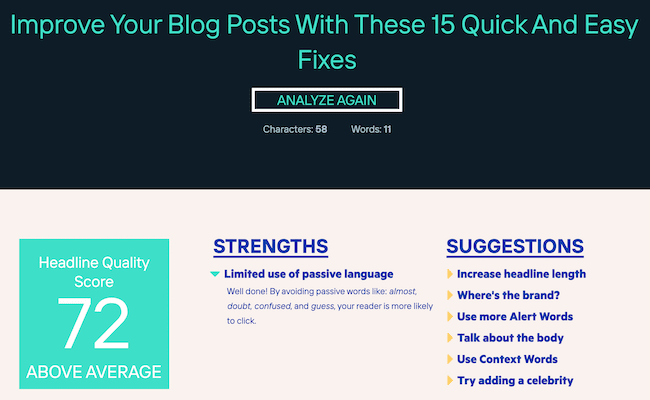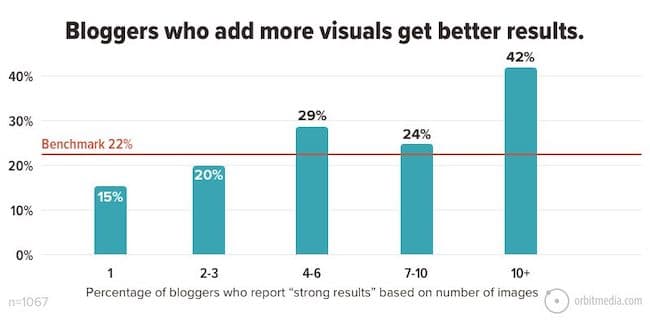Are you attracting enough readers to your blog? No? Well, here are some simple ways to improve your blog posts.
Writing lots of articles for your blog is great. But you need to consider many features apart from your text.
Your writing needs to be informative, engaging, and well researched.
But just as important is how your posts look and how well you optimize for search engines.
15 Proven ways to improve your blog posts
You’ve probably read a lot of advice about writing quality articles.
The advice is often a little vague, such as writing for your readers, not Google, thinking about search intent, and that search engines only index high-quality content.
While true, these don’t give you a very clear guide.
In response to a question about quality, John Muller from Google gave this definition.
When it comes to the quality of the content, we don’t mean like just the text of your articles.
It’s really the quality of your overall website. And that includes everything from the layout to the design.
Like, how you have things presented on your pages, how you integrate images, how you work with speed, all of those factors they kind of come into play there.
Source: Search Engine Journal
So there are many improvements you can make apart from writing terrific texts.
Best of all, most of them are relatively easy to do.
1. Keywords still matter
Yes, the days of keyword stuffing are well and truly in the past.
However, researching your main keyword phrase is still a vital part of writing for SEO (Search engine optimization).
When you select well, you give search engines a clear hint about the topic of your blog post.
You should include your keyword phrase in your article title, SEO title, and meta description. Also, include it naturally in your article once every 3-400 words, which is usually more than enough.
2. Write for your readers
A great article or blog post often solves problems for readers. You can write listicles, product reviews, how-to guides, or offer first-hand advice.
When you think about how to help your readers, topics for new articles are much easier to find.
At the same time, you want your articles to be informative, interesting, and engaging.
Sometimes it can be as easy as changing your point of view from the first to the second person.
It’s also an easy way to improve your existing posts because all you need to do is rewrite and change a few sentences.
For example:
I always ask someone else to proofread my new articles.
You can always ask someone else to proofread your new articles.
It’s as easy as that. With this simple change, you are engaging your reader.
3. Write an effective introduction
You only have a few seconds to gain a reader’s attention.
An introduction of between 3-5 sentences is the most effective.
Give your reader a clear outline and also reasons why they should keep reading.
When you write these few sentences, keep in mind how well they will quickly hook a reader’s interest.
If some of your existing posts start with a huge chunk of text, consider adding a new introduction.
4. Add a table of contents
You can find many free table of contents (TOC) plugins for most blogging platforms.
Adding a table of contents to your blog benefits your readers and your SEO.
For readers, it gives a quick overview of your article. If you position it after your introduction, it also helps keep their attention.
Readers can also click on one of the lines to go straight to an item that interests them.
It’s also a great addition to improve your SEO very quickly.
Each link in your table of contents can be indexed; sometimes, search engines will use them as site links.
You can see in the image below how Google uses the TOC above to add site links below the search result.
If you only make one improvement to your blog from my list, this is the one to do.
Adding a table of contents will apply to all your existing posts, so it will improve your entire blog with only a few minutes of work.
5. Craft a powerful headline
Always take the time to craft your titles or headlines carefully.
You can use an online analyzer to help you.
I always aim to get an above-average score.
It’s not only for new posts. You can improve your blog posts by updating your existing posts with a new and better title.
6. Persuasive and informative subheadings
Like your main title, your subheadings serve to engage and keep your reader’s interest.
You can use H2 or H3 headings, which will appear in your table of contents.
Keep in mind that they can also be indexed and added as site links to your search engine listings.
7. Use short paragraphs
Avoid using long chunky paragraphs for any online writing you publish.
Break up your text into shorter paragraphs to make it easier for your blog readers.
It’s a simple, quick, and easy way to improve your existing posts and articles.
Give your readers plenty of space to make reading much easier.
8. Use a clear and SEO-friendly URL
Most blogging platforms automatically convert your article title into the post’s URL.
You can see below how I edited the URL for this post to only the essential words.
Also, avoid dates, numbers, or any unnecessary words in your URLs.
The only word of warning is that you should not edit any URL for your existing posts. If you do, you will lose your search engine indexing and ranking.
The only way you can do it is to use a 301 redirect from your old URL to your new URL. But even then, you might still lose your SERP (search engine results page) position.
9. Include an author box
Like adding a table of contents, including an author box can improve your entire site.
Most blog themes have an option to add your author profile at the end of each article.
Keep it simple, but always include a profile image. Blog themes often use your Gravatar image, so it’s easy.
I keep mine short and sweet. But you can usually add social links or a link to your about page if you wish.
The big benefit of an author box is that it can help you a little with your E-A-T rating.
E-A-T stands for expertise, authoritativeness, and trustworthiness, and Google uses it as a measure of your competence to write on a subject.
An author box helps show why you are an expert in your field of writing.
10. Appropriate article length
It’s a bit like how long is a piece of string.
You might read that longer articles perform better for SEO.
It could be true to some degree because the more words you write, the more chance you have of gaining search engine queries.
But when an article is too long, it can be a struggle or boring for readers.
The right length is when it’s long enough to cover your topic in full.
Yes, perhaps 1,000-1,500 words is a sweet spot.
But sometimes, you might only need 500 words to cover something like a quick grammar point.
11. Add proof visuals to improve your blog posts
Yes, you can certainly use decorative images to break up your text.
But a better approach is to use visuals that prove or summarize your point.
Graphs and tables are always winners because they are quick and easy to understand.
You can also use screenshots, videos, or photos you have taken.
While researching this article, I read a terrific (and very long) post by Orbit Media about blogging statistics.
Almost every point in the piece included a graph. Here’s an example proving that visuals can help you improve a blog post.
So when you can, think about including images and visuals about your topics. Also, add descriptive alternative text to your images.
12. Include helpful links
You can use two types of links in your posts.
The first category is internal linking. Use these to link between your articles. When writing a new post, add links to your previous articles that are relevant to your new topic.
Also, go back to your existing posts and a link to your new piece on a few of them.
Three or four internal links are usually enough. But you can include more on longer texts.
These links help your reader find more information. But importantly, they help search engines find and index your new article.
The second link is external. It is when you link to a resource on another site. You use these to validate or prove a point you are raising.
Optionally, you can add a nofollow directive if you don’t want search engines to follow the link.
You would use this for sponsored or commercial content or social media links.
But if the resource is useful and valuable, you should stay with a dofollow link to give SEO credit to the content producer.
13. Include related posts
You can add these automatically with most blogging platforms or themes.
Add a maximum of three related posts at the end of your article.
There are two benefits.
One is that they can help keep a reader on your site.
The second is that search engines will notice the links and help give a little extra weight to your posts.
14. Check your schema settings
Again, this is often an automatic feature of your theme or a plugin like Yoast.
For articles, it’s quite basic information such as date published and date modified.
But with Schema set correctly, you can be sure that search engines will recognize you as the original author.
15. Always add a summary
Under a clear heading, write a few paragraphs to summarize your article.
You can recap some important points or add a little extra information.
Sure, many readers will not get that far in your article. But a lot will. So give them just a little more to round off your blog post.
Conclusion
I have been blogging for a very long time, and the best practices today are not the same as 15, 10, 5, or even 2 years ago.
SEO is constantly changing, as are readers’ habits and expectations.
I use all the items in my list above, and they help me find new readers from organic search.
Not only that, I get a lot of direct traffic from readers who know of or have bookmarked my site.
Yes, you need to write extremely well and stick to your niche subject area of expertise. But never forget that SEO is also vital to your success as a writer.
Blogging is always fluid. You can and should update and improve your existing blog posts regularly.
But making a few global changes, such as adding a table of contents, an author box, and related posts, can have an immediate positive effect.
The post Improve Your Blog Posts In A Flash With These 15 Easy Fixes appeared first on Just Publishing Advice For Writers and Authors.
Go to Source
Author: Derek Haines







